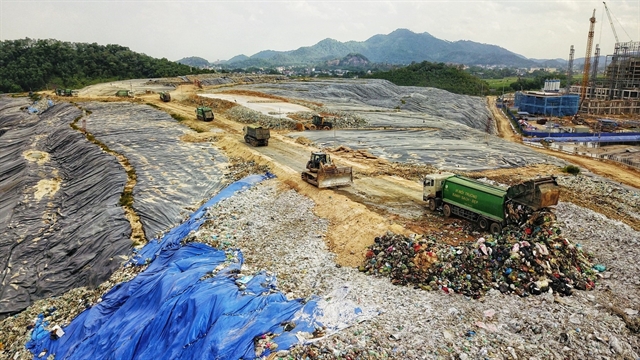 Environment
Environment

Plastic waste can take up to hundreds of years to decompose, creating an increasing burden on landfills, particularly when the sites run out of space to bury garbage.

|
| Trucks carry waste to Nam Sơn landfill in Hà Nội. Among the waste, there is a lot of plastic bags and other plastic items which take up to 200 years to decompose. —VNA/VNS Photo Thành Đạt |
HÀ NỘI — Plastic waste can take up to hundreds of years to decompose, creating an increasing burden on landfills, particularly when the sites run out of space to bury garbage.
The Nam Sơn Waste Treatment Complex, the largest landfill in Hà Nội, is a vivid example.
The complex was built in 1990 in the city’s Sóc Sơn District and spans over 157ha divided into two phases.
In its first phase, 10 trash burial slots were opened, accounting for 83ha, while the second one included eight slots spanning 73ha.
All the first phase slots have been filled.
The landfill's southern area, spanning 36ha, has six trash burial slots and has been operational since 2015, with a capacity of about 5 million cubic metres of trash.
All these slots were filled by 2019, prompting the Hà Nội People's Committee to allow Hà Nội Urban Environment Company (Urenco) to add two more slots and make use of the gaps between old ones to increase capacity.
Meanwhile, the landfill's northern area, part of the second phase, has not commenced construction due to clearance problems prevalent since 2015.
It would span 37ha and have two trash burial slots with a capacity of 1.9 million cubic metres.
When the project on the landfill was first planned, it was expected that after 20 years in operation, waste collected in the landfill would decompose.
It was also said that after the trash burial slots stopped receiving trash for a few years, they could be reopened, so it would not be necessary to expand the landfill’s area.
However, things have gone differently.
Lê Duy Dũng, head of Planning Department of URENCO 8 which manages the landfill, said that due to large amount of plastic waste which decomposed slowly, more space for dumping was needed.
The Nam Sơn landfill receives about 5,000 tonnes of waste daily from 17 districts of Hà Nội, he said, adding that about 10 per cent of the waste was plastic.
“Trash burial slots piled as high as 35m above the ground will not be allowed to receive any more garbage and will have to be covered with HDPE sheets to prevent rainwater from leaking in and the stench from creeping out,” he said, adding that 10 trash burial slots of the first phase were unable to get more trash.
Chemicals that were used during the waste treatment process could not penetrate deeply into the huge waste piles, which also hindered the decomposing process, Dũng said.
Vice director of URENCO 8 Nguyễn Quốc Tuấn said the landfill would always be overloaded as waste decomposed slowly while the city discharged more and more waste daily.
Prof and Dr Đặng Kim Chi from Việt Nam Natural and Environmental Protection Association said environmental pollution in and around landfills caused anger from people living around the landfill.
People and local authorities found it hard to accept landfills being opened in their neighbourhood, Chi said.
For Nam Sơn landfill, among measures to address environmental pollution at the landfill and surrounding residential areas, the Hà Nội People’s Committee decided to move all people out of the area within a radius of 500m of the landfill and to grow trees as a green corridor. Some 1,100 households in the three communes will move out of the total area of about 396ha around the landfill.
However, concerned over the serious environmental pollution and compensation issues, affected people have protested, blocking the way to the landfill several times since last year.
Meanwhile, as plastic waste is still common due to improper waste classification, plastic waste finally ends up in landfills. Without a place to dump the waste, trash piles up on the city streets, as has happened when the way to Nam Sơn landfill was blocked. VNS